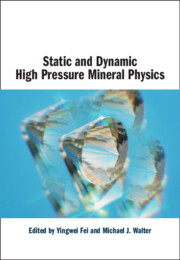Book contents
- Static and Dynamic High Pressure Mineral Physics
- Static and Dynamic High Pressure Mineral Physics
- Copyright page
- Contents
- Contributors
- 1 Introduction to Static and Dynamic High-Pressure Mineral Physics
- 2 Development of Static High-Pressure Techniques and the Study of the Earth’s Deep Interior in the Last 50 Years and Its Future
- 3 Applications of Synchrotron and FEL X-Rays in High-Pressure Research
- 4 Development of Large-Volume Diamond Anvil Cell for Neutron Diffraction: The Neutron Diamond Anvil Cell Project at ORNL
- 5 Light-Source Diffraction Studies of Planetary Materials under Dynamic Loading
- 6 New Analysis of Shock-Compression Data for Selected Silicates
- 7 Scaling Relations for Combined Static and Dynamic High-Pressure Experiments
- 8 Equations of State of Selected Solids for High-Pressure Research and Planetary Interior Density Models
- 9 Elasticity at High Pressure with Implication for the Earth’s Inner Core
- 10 Multigrain Crystallography at Megabar Pressures
- 11 Deformation and Plasticity of Materials under Extreme Conditions
- 12 Synthesis of High-Pressure Silicate Polymorphs Using Multi-Anvil Press
- 13 Investigation of Chemical Interaction and Melting Using Laser-Heated Diamond Anvil Cell
- 14 Molecular Compounds under Extreme Conditions
- 15 Superconductivity at High Pressure
- 16 Thermochemistry of High-Pressure Phases
- Index
8 - Equations of State of Selected Solids for High-Pressure Research and Planetary Interior Density Models
Published online by Cambridge University Press: 03 August 2023
- Static and Dynamic High Pressure Mineral Physics
- Static and Dynamic High Pressure Mineral Physics
- Copyright page
- Contents
- Contributors
- 1 Introduction to Static and Dynamic High-Pressure Mineral Physics
- 2 Development of Static High-Pressure Techniques and the Study of the Earth’s Deep Interior in the Last 50 Years and Its Future
- 3 Applications of Synchrotron and FEL X-Rays in High-Pressure Research
- 4 Development of Large-Volume Diamond Anvil Cell for Neutron Diffraction: The Neutron Diamond Anvil Cell Project at ORNL
- 5 Light-Source Diffraction Studies of Planetary Materials under Dynamic Loading
- 6 New Analysis of Shock-Compression Data for Selected Silicates
- 7 Scaling Relations for Combined Static and Dynamic High-Pressure Experiments
- 8 Equations of State of Selected Solids for High-Pressure Research and Planetary Interior Density Models
- 9 Elasticity at High Pressure with Implication for the Earth’s Inner Core
- 10 Multigrain Crystallography at Megabar Pressures
- 11 Deformation and Plasticity of Materials under Extreme Conditions
- 12 Synthesis of High-Pressure Silicate Polymorphs Using Multi-Anvil Press
- 13 Investigation of Chemical Interaction and Melting Using Laser-Heated Diamond Anvil Cell
- 14 Molecular Compounds under Extreme Conditions
- 15 Superconductivity at High Pressure
- 16 Thermochemistry of High-Pressure Phases
- Index
Summary
Our ability to determine the density (specific volume) as a function of pressure and temperature has drastically improved in the last several decades, with the combination of synchrotron X-ray diffraction and high-pressure techniques such as laser-heated diamond-anvil cell and large-volume multi-anvil press. The improvements are in both pressure–temperature range and data quality, and obtaining high-resolution 2D angle-dispersive diffraction data at over a megabar pressure and above 2,500 K is now routine. In parallel, dynamic compression techniques, such as laser-driven shock wave and magnetically accelerated flyer plate-impact experiments, have provided new ways to measure density at extreme conditions. The combination of static and dynamic compression data allows us to examine internal consistency in pressure determination and establish reliable pressure scales. Internally consistent pressure scales for several pressure standards are emerging through extensive comparison of compression data over a large pressure range and simultaneous measurements of elasticity and density. A concerted effort is needed to further expand and improve measurements under simultaneous high pressure and temperature, particularly at temperatures above 2,500 K, in order to accurately model the thermal pressure. To decipher the compositions of the Earth’s interior based on density observations from seismology requires high accuracy in measuring the subtle compositional effects on the density of mantle and core materials. For a universal understanding of the thermal equations of state of solids, the emphasis should be on reconciling the static and dynamic data of well-studied materials that have substantial overlap in pressure–temperature ranges.
- Type
- Chapter
- Information
- Static and Dynamic High Pressure Mineral Physics , pp. 147 - 188Publisher: Cambridge University PressPrint publication year: 2022



